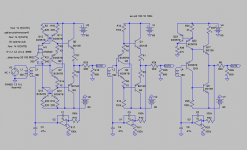Hi Jocko!!
😉
Why they are so complicated... I really dont know... to maximise performance when driving the difficult load they where used to isolate the source from??
Why dont you continue? hehe..
Sonny
😉
Why they are so complicated... I really dont know... to maximise performance when driving the difficult load they where used to isolate the source from??
Why dont you continue? hehe..
Sonny
Hi all,
I will repeat my use for the buffer one more time:
I use a MOSFET buffer as the active stage in my preamp. The volume pot hardly ever goes beyond 12 o'clock. This means the gain of my preamp is about -20dB. The gain of my poweramp is about 20dB. So I figured that I only needed a buffer.
I started to investigate some buffer datasheets (see this post earlier) and the suggestions of the responses. The lead me to believe that a simple, good performing buffer can be easely made, giving good sound for a ridiculous small amount of money.
First results are promising and validate the gain needed for (evening)-listening.
greetings,
Thijs Schrama
PS.
I would like to thank everybody for their comments. I'm more in to the Mega Rectifier Amp thing now, but I will come back with the final results of the buffer-amp project...
I will repeat my use for the buffer one more time:
I use a MOSFET buffer as the active stage in my preamp. The volume pot hardly ever goes beyond 12 o'clock. This means the gain of my preamp is about -20dB. The gain of my poweramp is about 20dB. So I figured that I only needed a buffer.
I started to investigate some buffer datasheets (see this post earlier) and the suggestions of the responses. The lead me to believe that a simple, good performing buffer can be easely made, giving good sound for a ridiculous small amount of money.
First results are promising and validate the gain needed for (evening)-listening.
greetings,
Thijs Schrama
PS.
I would like to thank everybody for their comments. I'm more in to the Mega Rectifier Amp thing now, but I will come back with the final results of the buffer-amp project...
This Circuit http://www.diyaudio.com/forums/attachment.php?postid=40581 looks like a stasis Output Topology used by Nealson pass when he was with threshold. maby Mr. pass can comment on this.
Old but still valid Class-A buffer thread
Found this old thread while searching for a buffer for a hybrid phonostage I am working on.
Had to compare the Walt Jung concept against an adjusted version of the circuit from the first post(current-PI). Contrary to the negative judgements this one works splendid in Spice environment.
It is for feeding 50Vrms into 1,2k even if the nominal input voltage is 1,2Vrms. Don´t mind the two 600ohms, just think of it as a 1,2k load!
The last one is at least as good as the others wrt overtones (even better as it has lower 3rd and a litte higher 2nd), phase and frequency respone.
Used the std spicemodels I had. I am not into solid state so please explain what is wrong to use the concept from the first post?
http://www.eflatjump.se/BJTbufferjfr.asc
Found this old thread while searching for a buffer for a hybrid phonostage I am working on.
Had to compare the Walt Jung concept against an adjusted version of the circuit from the first post(current-PI). Contrary to the negative judgements this one works splendid in Spice environment.
It is for feeding 50Vrms into 1,2k even if the nominal input voltage is 1,2Vrms. Don´t mind the two 600ohms, just think of it as a 1,2k load!
The last one is at least as good as the others wrt overtones (even better as it has lower 3rd and a litte higher 2nd), phase and frequency respone.
Used the std spicemodels I had. I am not into solid state so please explain what is wrong to use the concept from the first post?
http://www.eflatjump.se/BJTbufferjfr.asc
Attachments
- Status
- Not open for further replies.
